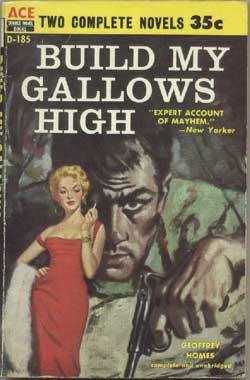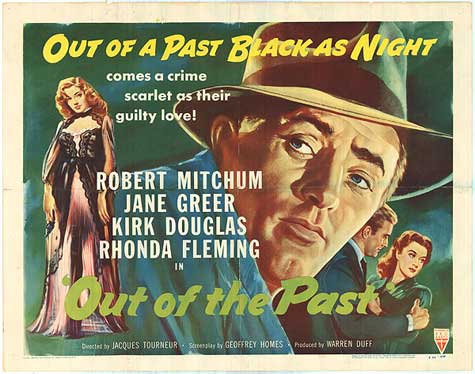 I didn’t set out to make a habit of, when writing appreciations of books for this site, also commenting on movies that were made from the novels. Ditto discussing the books that were converted into the films I cover. But oftentimes it just makes sense to do this. There’s usually something interesting in the connection between books and the movies that get made from them, and when you know one but not the other, then experience the other, you often come away with some new insights into the story in the medium to which you were already hip.
I didn’t set out to make a habit of, when writing appreciations of books for this site, also commenting on movies that were made from the novels. Ditto discussing the books that were converted into the films I cover. But oftentimes it just makes sense to do this. There’s usually something interesting in the connection between books and the movies that get made from them, and when you know one but not the other, then experience the other, you often come away with some new insights into the story in the medium to which you were already hip.
Anyway, when writing about the novel that was turned into the classic 1947 movie Out of the Past, there’s just no way around commenting on the film. Ask 100 film noir buffs to list their all-time top 10 examples from the genre, and my guess is at least 80 of them (if not more) would include Jacques Tourneur’s 1947 masterpiece on their tally. Yet I wonder how many of those 80 or more have read the book – Build My Gallows High (1946), penned by Daniel Mainwaring under the pseudonym of Geoffrey Homes – that is the foundation of the big screen feature. I’ve been an avid watcher/reader of both noir film and fiction for decades, first saw and was blown away by Out of the Past many years back, but I’ve only just now read the novel. The book is out of print, as best I can tell was last issued by Film Ink in 2001. And there is no e-book version, at least that I can find. So it’s fair to say it’s a lost title. And, having just taken it in (I got it in one of the Ace 2-for-1 editions, with a Harry Whittington novel attached), I can say it’s a classic.
Mainwaring is noted (again, as Homes) as the screenwriter of Out of the Past, although it seems other writers had their hands in the script’s development, one of those others being James M. Cain. But Mainwaring/Homes got the credit for adapting his own novel, and from that point on he left off fiction writing and gave his full writer’s attention to scribbling for films. He wrote the script for the original Invasion of the Body Snatchers, among other notable titles. Prior to authoring Gallows and several other suspense titles before it, Mainwaring worked as a reporter for the San Francisco Chronicle.
But let’s get back to the book under discussion. There are differences – some minor, others major – between the novel and movie, but the primary gist of Build My Gallows High mirrors what is exhibited in Out of the Past. At the beginning of the book, we are introduced to a fella named Red Bailey (he’s Jeff in the movie, perhaps because Robert Mitchum who played him didn’t have a carrot top). Bailey runs a gas station in the small town of Bridgeport, California. His business is doing well enough and he’s got a thing going with a pretty local girl named Ann Miller. Ann’s parents aren’t sold on Bailey as a suitor for their daughter, would rather see her with the local game warden who’s been in love with her for ages. Ann’s more taken by Bailey, though, and wants to marry him. Bailey has bigger problems than his would-be in-laws’ mistrust of him and the competition from another of Ann’s suitors, though. He has a past, a dark one, and it’s about to catch up to him for the first time in 10 years.
A decade before, Bailey (actual name Markham) was running a detective agency in New York City, he and a partner. They weren’t getting rich doing that work, so Bailey didn’t say no when a well-off gang boss named Whit Sterling offered Bailey (we’ll stick with calling him that, since that’s the name he goes by in the book and film) a large sum to do a job that was personally meaningful to him: he hired Bailey to find his former girlfriend, who shot him (but without managing to kill him) and stole a large wad of his cash, before disappearing into the sunset. Sterling wanted both the girl and the money back and the amount of dough he was willing to lay on Bailey to pull this off was enough that Bailey could use it to realize his dream of buying out his partner and going into business on his own.
Bailey had little trouble tracing the girl (Mumsie McGonigle in the book, Kathie Moffat in the film) to Acapulco. But completing the job of hustling her and Sterling’s large stash of green back to New York was not as easy. His heart got in the way, well that and his libido. Turned out this Mumsie was not only even prettier than what she appeared to be in the photo Bailey was shown of her, but also alluring personally. She induced Bailey to fall for her, he bit, and soon he decided not to tell Sterling that he located her. Instead, the two made plans to stay together. Bailey kept up this strategy even after he learned that Mumsie had been lying to him about Sterling’s money; she swore to him she never took it, but Bailey found evidence to the contrary. But by then he was already hooked, by her and by his deceitful plan. As it’s so nicely put by the omniscient narrator of the novel:
When a man had it bad, there was no hope for him.
Again, there are differences between the book and movie in how all plays out when Bailey finds the girl and all that happens after. But one thing that’s the same in both versions of the story (and this is the last spoiler I’m going to do here) is that Bailey and Mumsie got found by Bailey’s partner from the detective agency. The guy, Fisher, wanted a chunk of change to keep from ratting the pair out to Sterling. He and Bailey got into a physical fracas, and Fisher came away dead. How he died in the book is not the same as how it occurs in the movie, and that’s all I’m saying about that. But in both versions, Bailey buried his dead body and beat town, separate from the broad whom he then knew to be black-hearted.
So, 10 years after all of that, Bailey’s pleasant life in Bridgeport is interrupted when he gets visited by someone tied in with the Sterling/Mumsie drama from way back. Bailey is asked to go to San Francisco, to look in on this particular lawyer, via the man’s personal secretary. In the novel he’s given this assignment by way of a former cop from New York, and in the movie his orders are straight from Sterling. But in both cases he’s instructed to get from the attorney, with the man’s assistant’s help, some papers that are incriminating to Sterling. Bailey doesn’t want to do the job but knows he will be forced to because it’s being given to him by people who know about Fisher’s death and who are using that information as a vice through which to control him. So he leaves the gas station in the hands of the deaf-mute kid who helps him run it, parts ways with Ann for the time being, and goes off to the Bay Area. And that’s when the real party starts.

In both the book and film, the full tale is woven by alternating past events with the present. In the novel, Mainwaring/Homes handles these alternating perspectives seamlessly, bringing the full tale together in a way that is more interesting and more suspenseful than it would have been if he’d simply told the New York part in full, then forwarded to the Bridgeport piece and then the San Francisco subplot. By showing us where Bailey is in his life in the small town, then all that happened with him around the Sterling/Mumsie fiasco, and only then forging ahead to the developments in SF, he gives you a complete and highly compelling view of the torn existence Bailey leads.
Some of the best passages from the novel come from the time when Bailey was with Mumsie, just after chasing her down in Acapulco. These segments perfectly capture the home truth that is the essence of the story: how we can sometimes knowingly act in ways we realize are wrong, because a force that’s momentarily stronger than our conscience has a hold over us. I was struck by this passage from the novel:
Mumise wouldn’t stay in the cabin with Fisher’s body. They went down by the creek and waited for dark and now there was a wall between them. It would be all right, he kept telling himself, because he wanted it to be, because he didn’t want to lose her, because he wanted to stay blind. When you create something, you hate to see it dissolve into nothingness.
Of course, as the movie title suggests the other theme of the story is that of a person trying to escape his troubled past, trying to bury old misdeeds in hopes of leading a new, unblemished life. And then there’s the part about how one cunning temptress can lead a whole bunch of lovesick guys around by their hearts and their balls, and in so doing ultimately threaten all their lives with peril. Mainwaring’s/Homes’s novel tackles all of these matters in its own way and Tourneur’s film does so via means that are both similar to, and deviations from, the novel. Both are classics. Most people reading this probably already know that about the movie. More should become acquainted with the book.
Brian Greene's short stories, personal essays, and writings on books, music, and film have appeared in more than 20 different publications since 2008. His articles on crime fiction have also been published by Crime Time, Paperback Parade, Noir Originals, and Mulholland Books. Brian lives in Durham, NC with his wife Abby, their daughters Violet and Melody, their cat Rita Lee, and too many books. Follow Brian on Twitter @brianjoebrain.
See all posts by Brian Greene for Criminal Element.

This book seriously needs to be put back in print. I read it last month and it was very difficult to find a copy of it.
Sharp post, Brian. And such a very important book should be in print and I didn’t realize it wasn’t. What a shame! I have an extremely worn copy in storage somewhere.
Unkletom: Clearly, I agree.
David: thanks for the words. And yes, strange, and wrong, that this one’s not more readily available.